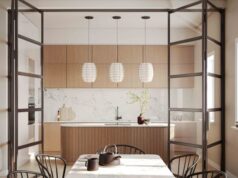
When designing or renovating a kitchen, splashbacks aren’t just a design feature, they play a key role in safety and compliance with Australian building regulations. This article explains the latest standards you need to follow for splashback installation, especially near cooktops.
What is a splashback?
A splashback is a surface installed behind a cooktop, sink or benchtop to protect the wall from heat, moisture, food splatter and grease. While they’re often chosen for their aesthetic appeal, splashbacks must meet strict safety standards, particularly when positioned behind gas or electric cooktops.
Clearance requirements behind cooktops
Gas cooktops
Gas cooktops require greater consideration due to open flames and higher temperatures. The key reference for safety here is the AS/NZS 5601.1:2022 Standard, which outlines the following:
- A minimum clearance of 200mm is required between the nearest gas burner and a combustible surface (such as timber, laminate or plasterboard).
- If 200mm clearance is not achievable, a non-combustible material (for example, stainless steel, toughened glass, tiles) or an approved heat shield must be used to protect the surface.
- The splashback must extend at least 150mm above the top of the rear burner.
It’s important to refer to your appliance manufacturer’s installation instructions, which may specify additional requirements.
Electric cooktops
Electric and induction cooktops generate less radiant heat, and currently, no regulated minimum clearance exists for combustible splashbacks. However, for safety and durability:
- Follow manufacturer installation guidelines.
- Use heat-resistant materials where possible.
- Ensure surfaces behind the cooktop are easy to clean and resistant to staining and discolouration.
Glass splashbacks
If you’re installing a glass splashback, it must meet the requirements of AS/NZS 2208, which governs safety glazing materials.
- Only toughened safety glass can be used behind a cooktop.
- Standard annealed glass is not permitted due to the risk of shattering under heat stress.
- Cutouts for power points and switches must be made before the glass is toughened.
Prohibited materials: Engineered stone
As of July 2024, the use of engineered stone (high-silica composite products) has been banned across Australia for all kitchen and bathroom applications, including splashbacks. This change follows serious health concerns related to silica dust exposure during cutting and installation.
If you’re renovating or building, opt for safer alternatives such as:
- Porcelain panels
- Natural stone (granite, marble)
- Ceramic tiles
- Stainless steel
- Toughened glass
Fire safety and compliance
All materials installed behind a cooktop must be either non-combustible or adequately shielded. Failure to follow the clearance rules or use compliant materials can void warranties, insurance coverage, or result in failed inspections.
It’s also essential to consider other safety factors:
- Adequate ventilation (especially with gas)
- Safe placement of electrical outlets
- Fire-resistant cabinetry and surrounds
Final tips
- Always consult the most recent Australian Standards and your appliance’s installation manual.
- Speak with your builder, kitchen installer or building surveyor to ensure your splashback plans meet local code requirements.
- Avoid DIY shortcuts: Non-compliant installations can be costly to fix and may pose serious safety risks.





